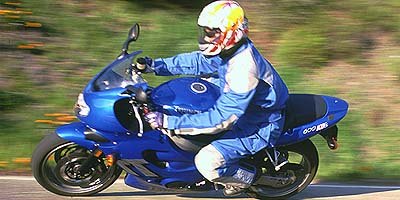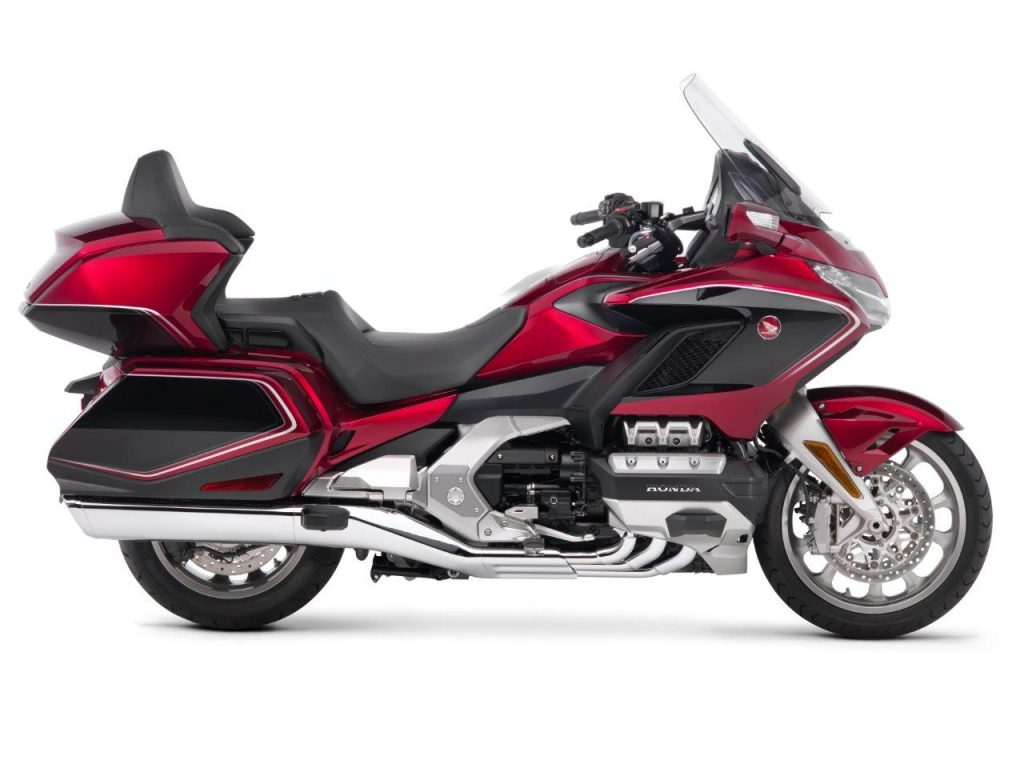Some suggested Triumph’s shot at a four-cylinder 600 sportbike should’ve been included in last week’s “Ten Worst Motorcycles of the Modern Era.” I think that’s way too harsh an assessment, but in any case, Triumph’s 2001 TT600 and the various inline Fours that followed it never quite got traction in the marketplace, and left the building after the 2006 Speed Four. Which wasn’t really a bad thing, as its demise led to the rise of the Daytona 675 and Street Triples shortly thereafter.
Torrance, California, March 21, 2001 — When Triumph debuted its T595 (now called the 955i Daytona) in 1997, people all over the world wanted to see the British marque do well. It was their first modern foray into the sportbike wars and Triumph did things right by doing things their way. Instead of going head-to-head with the Japanese by building an in-line four-cylinder-powered machine, they built a three-cylinder, fuel-injected motor and wrapped it in a unique frame.Next, Triumph covered their package with nicely sculpted bodywork devoid of splashy race-replica graphics – all of which helped the Triumph stand out from the pack while still leaving it a viable choice for riders who wanted open-class performance.
Enter Triumph’s new TT600, though, and Triumph is spitting into the wind. The boys in Hinckley would be hard-pressed to enter a segment of the motorcycle market that is more competitive than the 600 class. Think about it: this is the class that contains Yamaha’s R6, Suzuki’s GSX-R600, Kawasaki’s ZX-6R and Honda’s CBR600F4i. Surely, if they wanted to make a splash, they could have picked an easier target than this lot of bikes. And the fact that they deviated from their three-cylinder powerplant to go with a four puts them at an even greater risk. There can no longer be the argument that they’ve traded a bit of performance for a dash of character. They’re on equal footing now and they’re going to have to earn people’s respect.
Going head to head with the latest and greatest from Japan, if nothing else, deserves accolades for the gnarly brass ones it took to make and pursue that decision. But could a bike that first saw the drawing board in 1996 and rolled off the line last year really be competitive, even considering it is a first effort? When first we took delivery of the TT600, we thought its aesthetics left something to be desired. It looks somewhat like an F4 whose graphics have fallen off. Some see this as a bad thing, others think rather highly of the subtle look of the TT600. Then again, the subtle body work cloaks a beautiful bit of machinery underneath.
The liquid-cooled, DOHC in-line four-cylinder motor displaces 599cc thanks to 68mm x 41.3mm (bore and stroke) Nikasil-coated cylinders. The compression ratio is 12.5:1 and the fuel/air mixture is controlled by a Sagem MC1000 engine management computer. Fuel and air is delivered via multiport sequential electronic fuel injection with forced air induction through an 8.5 liter airbox. The motor’s power makes its way to the rear hoop thanks to a six-speed gearbox that uses a wet, multi-plate clutch.

The suspension consists of Kayaba units front and rear. The front is shod with 43mm cartridge forks featuring dual-rate springs. The fork offers adjustable preload, compression and rebound dampening. The rear Kayaba monoshock features a rising rate linkage and is also adjustable for preload, compression and rebound. The suspension is attached to an aluminum perimeter beam chassis and features a dual-sided, aluminum swingarm. The chassis and rear sub-frame weigh in at just 12.6 kg (27.8 lb) and use the engine as a structural member.
Braking duties (not to be confused with HackFu’s job of breaking duties) are accomplished by dual 310mm floating discs and four-piston calipers up front, while a single 220mm disc and a single piston caliper sit at rear. Separating the front and rear axles is 1,295 millimeters.
On the Road Again
Thankfully, we’re a considerate lot and tend to look beyond first-impression snafus. You see, when we picked up the bike, Minime was at the helm and had a nice shot to open up the throttle getting onto the freeway. Wide open in first gear at 4,000 rpm the bike just went waaaaah with no substantial increase in the rate of acceleration. Blah. But then, when the tach swung past 9,000 rpm – the seat fell off. Minime had to grab it with his knees to keep it from getting snagged on the undercarriage of a passing moto vehicle.
It seems that after we filled out the registration for the bike and it was placed under the seat (by somebody else) the latch didn’t quite, um, latch like we thought it did. Our fault there, but on we go, unfazed. Ergonomically speaking, the Triumph has a relatively upright riding position. The handlebars feel like they’re located similar to the units found on Honda’s excellent CBR600F4i, but the footpegs feel substantially higher. The peg placement also puts the rider’s feet a bit more forward than we commonly enjoy, reminding some people of Suzuki’s GSX-R, albeit with a decent reach to the bars. The riding position is a bit mis-matched for tall people, but bearable nonetheless.
At speed, wind protection is decent, though we would have liked the plastic windscreen and fairing to come up a little higher. And, speaking of the fairing, from the rider’s seat, it could look a bit cleaner. The sparse instrument cluster looks a bit last-minute, like a race bike, but it gives you what you need at a glance.
Into the twisties we go, and it’s here that we uncovered the Triumph’s strongest and weakest points. The chassis shines here but the Fi system’s poor mapping makes the going a hassle. So, the good stuff first…
“The suspension is well set-up, offering a good balance between control and a plush highway ride.”

When the pace heats up, however, we dialed in an extra click of compression and rebound in the front and went up similarly on the rear, along with an increase in preload. These small changes helped keep the bike from moving around so freely and allowed us to explore our local roads without much fuss. Letting off the excellent binders, turning the TT in towards a corner takes but a thought. The bike is extremely well-balanced and the first part of a turn was never a problem. It was only when getting back on the throttle to settle the chassis did the fuel-injection start to upset things – chassis and rider alike.

During any sort of off/on throttle transition, the bike would hesitate and then surge ahead, making even the Kawasaki ZX-9R’s severe carburetion glitch seem mild in comparison. Looking at the dyno chart from the TT600, you have to wonder if maybe they wouldn’t have been better off with old-fashioned carburetors. The graph is full of dips and flat spots that proper Fi mapping is supposed to eliminate, not to mention the meager power output of the 599cc motor that falls some 13 horses behind the class-leading GSX-R600.
You try to adapt, but the throttle seems to respond inconsistently so you never know exactly what to expect. Your best bet is to be smooth with rolling the throttle on before entering the corner and using body english instead of throttle to change lean angle of the corner arc. Exiting the corner, wind open the throttle and shut it down, get on the brakes, bend it in and repeat again. You can make good time on the TT600, but it requires more effort than it should.
Does it Work?
“The triumph is a fundamentally solid motorcycle and a perfectly good first shot at an in-line four.”
In the end, the triumph is a fundamentally solid motorcycle and a perfectly good first shot at an in-line four. It’s just too bad the competition in Triumph’s chosen sector of the sportbike market is so unforgiving. That, combined with some teething problems (mainly the fuel-injection system) hold back what could otherwise be a very viable option for riders who crave the spunk and light weight that only 600-class machines are able to provide.
Triumph’s TT600 is a solid first effort in a tough market segment from a company that is rich with history and tradition. In many ways, this TT600 lives up to the high standards of this great marque.
So, is it a real threat for the Supersport title? It’s a solid design that, unfortunately, has a few quirks too many when placed against the leaders in this ultra-competitive class. Then again, being that it bears the Triumph name and lineage will be more than enough to sway some buyers and raise the eyebrows of quite a few more.
Specification:Engine: 599cc, Liquid-cooled, DOHC in-line 4-cylinder Bore/Stroke: 68 x 41.3 mm Compression Ratio: 12.5:1 Fuel system: Multipoint sequential electronic fuel injection with forced air induction Ignition: Digital inductive type via electronic management system Transmission: 6 speed Frame: Aluminum beam perimeter Swingarm: Twin sided, aluminum alloy Wheels: Front: Alloy 3 spoke, 17 x 3.5in Rear: Alloy 3 spoke, 17 x 5.5in Tires: Front: 120/70 ZR 17 Rear: 180/55 ZR 17 Suspension: Front: 43mm cartridge forks with dual rate springs and adjustable preload, compression and rebound damping Rear: Monoshock with adjustable preload, rebound and compression damping Brakes: Front: Twin 310mm floating discs, 4 piston calipers Rear: Single 220mm disc, single piston caliper Length: 2060mm (81.1in) Width: 665mm (26.2in) Height: 1150mm (45.3in) Seat Height: 810mm (31.9in) Wheelbase: 1395mm (54.9in) Rake/Trail: 24°/89.1mm Weight (dry): 170kg (374lb) Fuel Tank Capacity: 18 liters (4.8 gal US)
Source link




